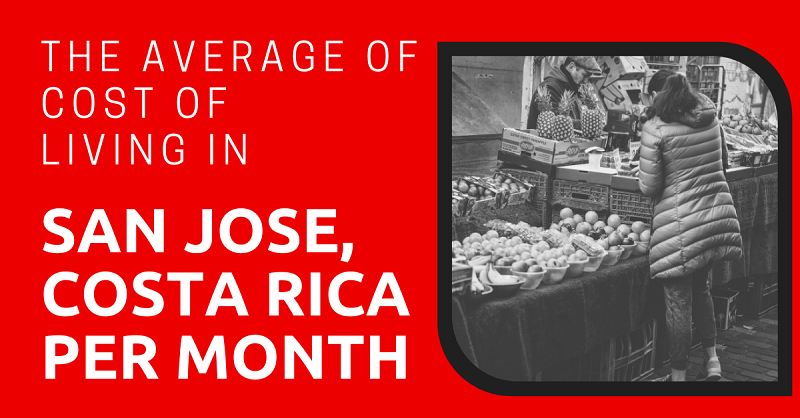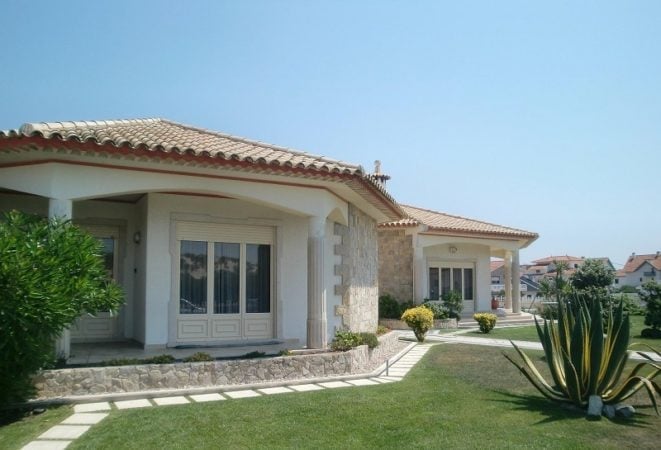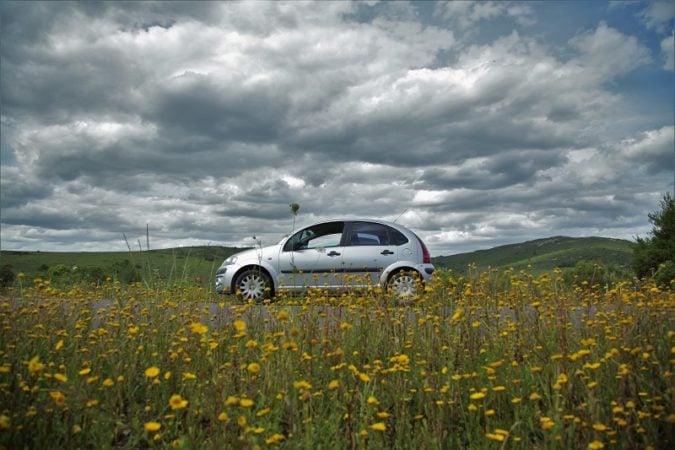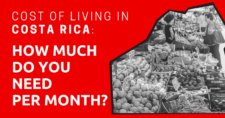
This article will take approximately 15 minutes to read. Don't have the time right now? No worries. Email the ad-free version of the article to yourself and read it later!
San Jose is the capital city of Costa Rica.
It’s one of the most popular destinations for expats moving here. The city has every facility and amenity you need to live comfortably. The healthcare system is also good.
In addition, there’s plenty to do in San Jose. You can dine out at nice restaurants, enjoy the beaches, shop at the many stores, go to the theater, watch movies, visit pubs, and see some cultural attractions. It’s also a great place to just take a leisurely stroll.
But what about the cost of living? How much do you need to live comfortably in San Jose, Costa Rica? Let’s find out.
Disclaimer: This article may include links to products or services offered by ExpatDen's partners, which give us commissions when you click on them. Although this may influence how they appear in the text, we only recommend solutions that we would use in your situation. Read more in our Advertising Disclosure.
Contents
Key Takeaways
- As the capital city, the cost of living in San Jose is among the highest in Costa Rica and Latin America.
- To live here as a single person, you should prepare to pay at least US$1,500 per month.
- If you have a family of four, then the cost can be around US$4,500 a month.
- The cost of groceries here is cheap. To lower your budget, you can buy food from farmers’ markets and cook it yourself.
- You should expect to pay around US$12 to US$17 per normal meal when eating out.
- However, the cost of cars here can be expensive due to the high tax.
Is It Cheap to Live in San Jose?
While Costa Rica is the most expensive country in Central America, it’s still significantly less expensive than the United States or much of Europe, making it one of the most popular places to retire in Central America.
As with many other places in the world, the prices of certain goods and services in certain areas in San Jose are cheap but quite expensive in others.
Nevertheless, you will find that most of the prices in San Jose are lower than in most cities in the United States and Europe.
For a general estimate, your monthly expenses as a single person living in San Jose are likely to be around US$1,200 to US$2,000. This can vary higher or lower depending on your choice of rent and lifestyle.
If you live here with a family of four, then the costs can range from US$3,500 to US$5,000 a month.
The choice of school for your children plays an important part in your family’s cost of living. If it’s a public school, then the cost can be less than US$200 a month. If it’s an international school, then it can exceed US$2,000 a month.
If you want to learn more about the cost of living in Costa Rica, check out this article.
Property Rentals
It’s usually recommended for expats who want to live in San Jose to try renting an apartment first.
For a furnished apartment that measures 85 square meters (900 square feet) in a city area, you can expect to pay 600,000 colones (US$1,200) a month.
If you were to take the same apartment size that’s also furnished, in a normal area, you would be paying 300,000 colones (US$600) per month instead.
For a furnished studio apartment that measures 45 square meters (480 square feet) in a city area, you can expect to pay 400,000 colones (US$800) a month.
If you were to take the same apartment size that’s also furnished, in a moderately priced area, you would be paying 250,000 colones (US$500) per month instead.
When it comes to a short-term rental, you can expect the average hotel room to cost anywhere from $75 – $150 per night.
A quick glance on Airbnb will show you rentals ranging from US$36-US$90, although most of the listings are around US$50 and thereabouts.
Other short term rentals will likely be offered at similar amounts.
Housing Prices
While housing prices vary depending on the area, they are generally very reasonable compared to some other areas in the world.
A 2-bedroom apartment with 85 square meters in San Jose can cost you US$200,000.
To buy a 3-bedroom with 174 square meters in Escazú, you should expect to pay around US$500,000.
A smaller-sized unit, like a studio, could cost around US$90,000.

To save money and have a healthier bank account, you can opt to buy an apartment outside of the city center instead — it will be significantly cheaper.
If you’re interested in buying a house instead of an apartment, you would likely have to live on the outskirts of the city.
You could find something small and adequate, probably with one bedroom for US$50,000. You could probably find something with 2-3 bedrooms for US$100,000.
For a decent house with several amenities, you can expect to pay about US$150,000.
Luxury houses normally start around US$250,000 and go upwards from there.
Groceries
Food is a non-negotiable expense in any spending plan. Everyone needs to eat, so it’s important to determine how much you’ll be spending on food before you move somewhere.
In general, you could probably buy a month’s worth of groceries for about 120,000 colones (US$240) for 2 people.
To give you more idea, here’s a list of grocery prices in Costa Rica.
- a dozen eggs: 1,754 colones (US$2.69)
- 1kg chicken breast: 5,100 colones ($10.16)
- a gallon of milk: 814 colones (US$1.25)
- bread for two people for one day: 793 colones (US$1.22).
Coffee is grown in Costa Rica and is highly regulated. Because of this, many coffee drinkers rave about the coffee. At around 950 colones (US$1.44) for a 200g-bag. The coffee here is cheap but high in quality.
In addition to grocery stores, there are several farmers’ markets in different areas in San Jose, where you can buy fresh produce priced lower than what you will find in regular grocery stores.
However, you should be aware that groceries in areas with a high expat population tend to have higher prices.
Also, imported goods are more expensive, while locally produced goods are significantly less expensive.
Dining Out
Most people don’t exclusively cook their own food.
Whether it’s to break from your usual fare or to enjoy a special dinner, many people enjoy eating out from time to time.
In San Jose, buying a basic meal from an eating place in the business district will cost around 8,000 colones (US$16). If you’re craving fast food, a combo meal in a fast food restaurant will cost you around 5,000 colones (US$10).

A nice dinner for two in a neighborhood pub would cost around 15,000 colones (US$30).
If you go to an Italian restaurant in the expat section of the city and get appetizers, wine, a main course, and a dessert, you could expect to pay 32,000 colones (US$64).
Transportation
Upon arriving in San Jose, you might want to go out and explore. Whether you’re looking to enjoy the city life or see the beautiful countryside, you will need transportation to go from one place to another.
Fortunately, there are a number of transportation options in San Jose, and the public transportation system is pretty great.
There are also car rentals, Uber, and taxis. In addition, San Jose is a very walkable city. If you are in good physical condition, you may prefer to just walk to go to places.
Otherwise, you have the following transportation options.
Public Transportation
Public transportation in San Jose is quite reliable, but it is important to make transportation arrangements or plan in advance.
Riding public buses is an option, and luckily there are a number of bus companies. Different bus companies have different schedules and destinations. You will also need to make sure that you go to the correct bus stop for the bus company you intend to take.
If you are taking a bus to go somewhere, you should expect to pay in colones. While many places in San Jose accept US dollars, paying a bus fare is one transaction in which you are expected to pay with local currency.
- Most fares for trips within the city will cost you around 250 to 275 colones (US$0.38 – $0.42).
- For certain destinations, a fare can cost as much as 500 colones (US$0.75), so be prepared.
Longer trips will, of course, cost you more. However, you can also use credit cards at bus stations for longer trips. You should also know that longer trips only have one stop, so plan accordingly.
There’s a reason why many expats use the public bus system. It’s cheap, convenient, and arrives at many destinations that people regularly go such as:
- Poas Volcano for about 1,830 colones (US$3.00)
- Tamarindo for 4,880 colones (US$ 8.00)
- Manuel Antonio for 3,050 colones (US$5.00)
- Quepos for 3,660 colones (US$6.00)
- Playas del Coco for 4,880 colones (US$8.00).
Taxis
The starting/flag fare for a taxi is 930 colones (US$1.80), and about 960 colones (US$1.76) per kilometers for the subsequent distance. This mean, for a 5km trip, you should expect to pay around 4,570 colones ($US8.80)
If you ask the taxi to wait an hour for you, you can expect the fare to cost around 3,775 colones (US$5.73).
Cars
Many people are interested in being able to get around with a car when they move to Costa Rica. After all, San Jose is at an important intersection on the Pan-American highway.
Unfortunately, cars in Costa Rica are terribly expensive due to import taxation.
For example, a Toyota Corolla would be about 17,000,000 colones (US$34,000). Prices actually get higher from there.

Then there’s the price of gas.
Initially, it doesn’t seem too bad at 728 colones (US$1.46) per liter of gas. However, when you realize that a liter is only about a quarter of a gallon, that brings the cost up to $5.54 a gallon in US dollars.
If you plan to drive in Costa Rica, you will also need to have a Costa Rica driver license.
Many people don’t own cars in San Jose. There’s a great public transportation system and taxis are reasonably priced if you need to get somewhere in a hurry.
Healthcare
Healthcare and dental care in Costa Rica are some of the best in the world, especially when it comes to price and quality.
Costa Rica provides two choices when it comes to healthcare: a universal health system through their CCSS (CAJA) and private healthcare insurance through their Instituto de Seguro Nacional (INS).
If you choose their universal healthcare system, you can expect to pay around $US60 per month depending on your declared income.
If you’re interested in private healthcare insurance, the price varies depending on the person’s age. For coverage for individuals up to 21 years old, it costs around 18,000 colones (US$30) per month. However, when you are older than 60 years old, you can expect to pay more than US$100 per month.
Once you’re insured within the system — either through universal healthcare or private insurance — and you’re up to date on payments, you may not have to pay for medical appointments or even prescriptions.
The only real downside to this system is that sometimes, healthcare facilities are crowded, and you might not have a say in which doctor sees you.
Read our guide to Costa Rica’s healthcare system for expats for more information.
Utilities
Utilities are pretty cheap in San Jose. It helps that it’s not cold enough to need heating, yet it’s not so hot as to make air conditioning a necessity.
Between electricity, water, and gas, a utility bill for an 85-meter-squared (900 square feet) apartment with two inhabitants can run up to about 48,000 colones (US$96).
If it’s a studio apartment with one inhabitant, the cost goes down to 34,000 colones (US$68).
Cable TV and Internet
It seems like the internet has really become a necessity in recent years. In San Jose, the cost of the internet is really reasonable too. For an internet plan with a speed of 45 megabytes per second, it’s just 22,500 colones (US$45) per month.
If you’re looking for something faster and more inclusive, you can get a bundle that will include internet with more than 45 megabytes per second, unlimited data, and cable for 27,500 colones (US$55) per month.
If you’re just interested in cable TV, the three main cable providers in Costa Rica are Tigo Star, CableTica, and Telecable. Some of them offer internet packages, as well.
Education
If you have children and they can speak some Spanish, you can enroll them in your local public school. They will need supplies, such as a uniform and books, but they’re not terribly pricey.
If you’re more interested in enrolling your child in an international school or a private school, you can expect to pay for tuition on top of regular school supplies.
In case it’s a private school, you should expect to pay between US$300 and US$1,200 per month. In case it’s an international school, it’s going to be between US$1,300 and US$2,000.
While it’s not cheap, it’s definitely not as expensive as that of schools in other parts of the world for private education.
Read our overview of Costa Rica’s schools and education system for more information.
Average Expense
Since everyone’s lifestyle is different, the average expense for each person living in San Jose is going to vary.
To give you a general idea, you need to have at least US$1,500 to live in San Jose as a single person. This includes renting an apartment outside the city area and the cost of eating out three to four times a week.
For a family of four, you should expect to pay around US$4,500 a month to live here.
Now, on to You
Unless you’re relocating from another city in Central America, it’s likely that moving to San Jose, Costa Rica will reduce your costs, particularly if you’re moving from the US or most EU countries.
San Jose is a beautiful city with a lot to offer. It’s beautiful, it has a considerable expat population, and it’s climate is great for just about everyone.
Regardless of where you’re moving, make sure you can afford to live in your desired destination and that you can enjoy living there. So if San Jose is your target destination, please take some time to visit the place before deciding to settle down there.
You will either love it or hate it. Either way, this guide will help you figure out if your finances can handle it!







